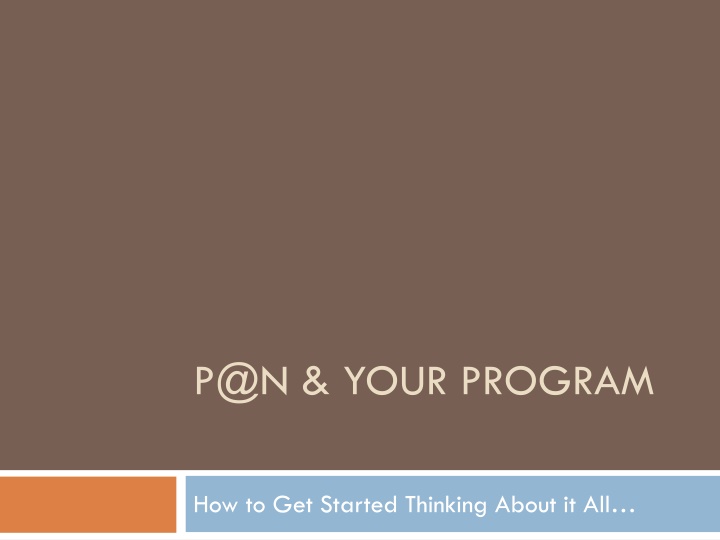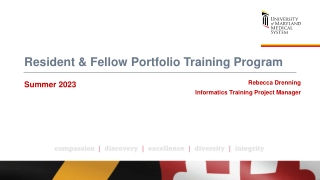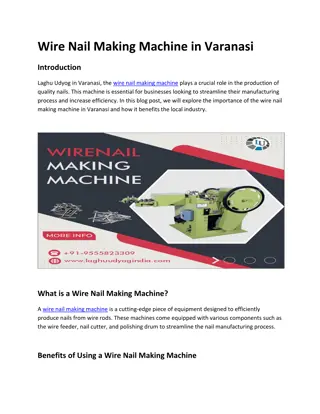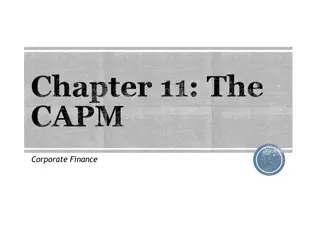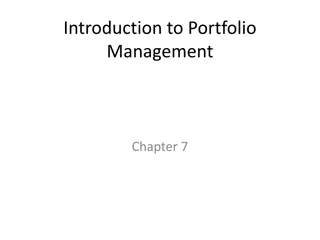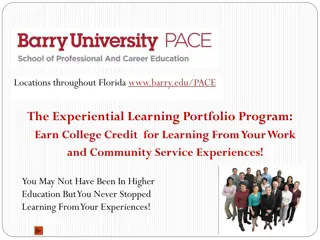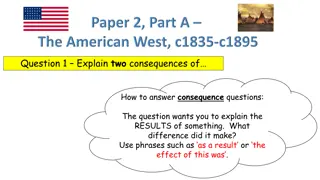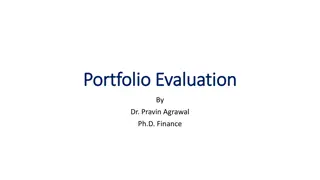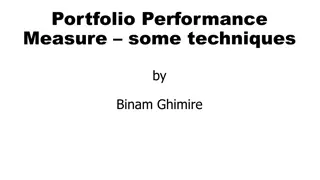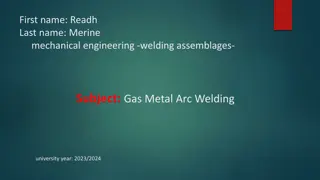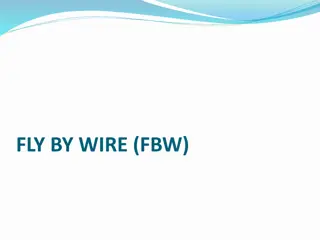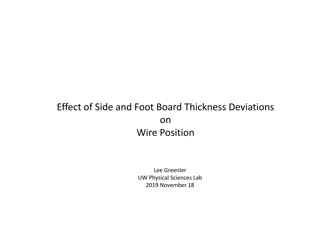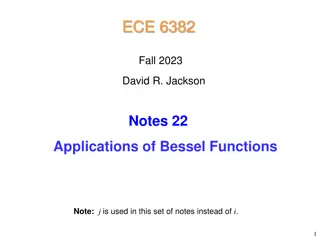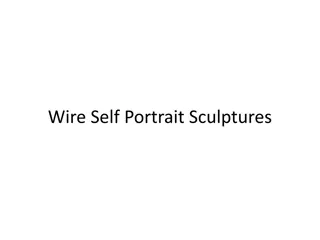An Overview of P@N: Portfolio@Naz Chalk & Wire for Student Assessment
Explore the functionalities of P@N, an electronic portfolio tool for students to archive, track their learning, and demonstrate knowledge. It provides a common interface for faculty/staff to assess student work against program SLOs, core rubrics, and criteria, aiding in program improvement and assessment. Discover how P@N streamlines portfolio creation, enhances reporting on student outcomes, and facilitates coordination of SLO data across Nazareth College programs.
Uploaded on Sep 24, 2024 | 0 Views
Download Presentation

Please find below an Image/Link to download the presentation.
The content on the website is provided AS IS for your information and personal use only. It may not be sold, licensed, or shared on other websites without obtaining consent from the author.If you encounter any issues during the download, it is possible that the publisher has removed the file from their server.
You are allowed to download the files provided on this website for personal or commercial use, subject to the condition that they are used lawfully. All files are the property of their respective owners.
The content on the website is provided AS IS for your information and personal use only. It may not be sold, licensed, or shared on other websites without obtaining consent from the author.
E N D
Presentation Transcript
P@N & YOUR PROGRAM How to Get Started Thinking About it All
What is P@N? Portfolio@Naz Chalk & Wire An electronic portfolio for students An assessment tool A tool for reporting results
What P@N isnt: Grading Software Course Management Software A Cure for the Common Cold
What can P@N do? For Students Archive work ( artifacts ) over time Submit artifacts to faculty/staff to be assessed Access archived artifacts later to use in a Portfolio (Program, Core, Personal Portfolio) Track their own learning Compile their work and demonstrate knowledge and skills for job applications
What can P@N do? For Faculty/Staff Provides common interface for faculty and staff to assess student work against program SLOs, core rubrics, and professional criteria Track student learning over time By Particular Student Learning Outcome By Individual Student In Aggregate Form Summative Program Portfolios/Capstone Experiences Reports for Assessment/Program Review
A Brief Aside: What is an artifact? A performance video Professional demonstrations Oral histories Graphic representations Multimedia Documents Spreadsheets Programs Apps Etc.
What are the benefits? Program Portfolios a breeze Ease of Reporting on Program s Student Learning Outcomes to Others Coordinating SLO Data across the College Show Nazareth College s Value Added for all programs (Liberal and Professional, Graduate and Undergraduate) and the core
Before We Get into the Nitty-Gritties... Assumptions: Your program has a working Assessment Plan You have a comprehensive and complete set of SLOs for your program Your SLOs are measureable You have established levels of proficiency You use your results to improve your program Your Assessment Plan has been judged Established Your program s faculty agree about your Plan
Where Do We start? The Two Big Questions: What do we want our students to get out of a Portfolio? What do we want to know about our students learning?
Overview Choosing a Portfolio Model Reviewing and Finalizing Your Program s SLOs Creating a Curriculum Map Matching Rubrics to SLOs & Artifacts Designing your Portfolio s Table of Contents Deciding on a Pilot
Your Programs Portfolio Lots of Models Which one is right for you? Chronological Model: Students upload artifacts in various courses (either assessed or not in each course) Students reflect on these artifacts in a Capstone Experience Benefits? Value-Added data if students assessed along the way
More Models.. Competency-Based Approach: Students upload artifacts to demonstrate competencies Benefits? External Accrediting Organizations Portfolio Course Model: Students create & upload artifacts in Milestone/Capstone course Benefits? With two course in program, value-added
Choosing a Model What does your program want to get out of the Portfolio? Brainstorm with us to develop a model that is appropriate for you to pilot
On to Your SLOs The next questions to ask: What are the Student Learning Outcomes of our Program? Do our SLOs really match what we want our students to learn? Do we want to measure our SLOs just at the end, or at beginning & end to get value-added data?
Curriculum Mapping And then ask: In which courses/activities do students produce artifacts that are relevant to our SLOs? When we map this out, are we forgetting any SLOs that are important to us, or to external bodies?
Example of a Curriculum Map Intended Student Learning Outcomes Awareness of careers and job opportunities in biological sciences Diagram and explain major cellular processes Courses Develop laboratory techniques Apply the scientific method BIOL 101 I I I BIOL 202 R R I BIOL 303 R M, A R BIOL 404 M, A M, A R Other: Exit interview A
Matching Rubrics to SLOs More questions to ask: Do we have rubrics for each of our Program s SLOs? Have we decided what is proficient (i.e., wouldn t be embarrassed to see them graduate at this level)? For Undergrad Programs: Do any of our SLOs match up with the Core SLOs? Could we use the Core Rubrics?
Check List So Far Clear idea of how students will benefit Clear idea of what program wants out of it (e.g., what kind of data regarding student learning would be useful?) Choose Portfolio Model Program SLOs AOK Curriculum Map created which states which courses will assess particular student SLOs Rubrics created for each SLO which is appropriate for artifact in courses in Curriculum Map SLOs & Rubrics coordinated with others (External, Core)
Now to Your Table of Contents The T of C is the framework of your Program s Portfolio that you create You create it; we ll load it into P@N for you This is what students see you give them Sections in which to place their artifacts In each Section, you give them detailed instructions You can have one or more summative Sections where they reflect on their artifacts and put it all together
A Second Check-List Design your T of C Sections, thinking about what will be uploaded in each, and from which course or activity Keep you eye on your Curriculum Map for this Assign a rubric for each artifact in each Section or Subsection Create instructions for students in each Section and Subsection Remember: Put yourselves in the shoes of your students. Is it fun and interesting? Is valuable and worthwhile?
Your Overall Time Line Semester 1 Think Work : Portfolio Model SLOs, Curriculum Map, Rubrics Table of Contents Semester 2 Paper First : Pilot Table of Contents & Rubrics on paper. Evaluate & Revise Revised T of C and Rubrics to P@N Technical Support; Testing in P@N Determine plan for Semester 3 (i.e., which courses, which students) Semester 3 Go Live : Use Table of Contents & Rubrics in P@N
Still to do Departmental discussion about what a 1 , 2 , 3 and 4 means examine student work together Inter-Rater Reliability Look at your Results! Use Results to Improve your Program and/or Show Off
What we Learned from our Pilots: Students pick it up in seconds Assessment in P@N is quick and easy for faculty Hard part is designing it all to get answer to the right questions The rubric is critically important Confusion between course grade & longer-term assessment Do I need to predict where a student will be in 4 years? (No!) Can a student score a 1 on the rubric, but still get a 95% in the course? (Yes!) Program MUST know what it hopes to learn from the portfolios BEFOREHAND Focus needs to be on the conceptual side, not the technological Name (P@N) can be confusing
Current Initiatives Dedicated Space in Library Student Team of Helpers Workshops The Queue Communication Faculty Year-End Data Sheets
